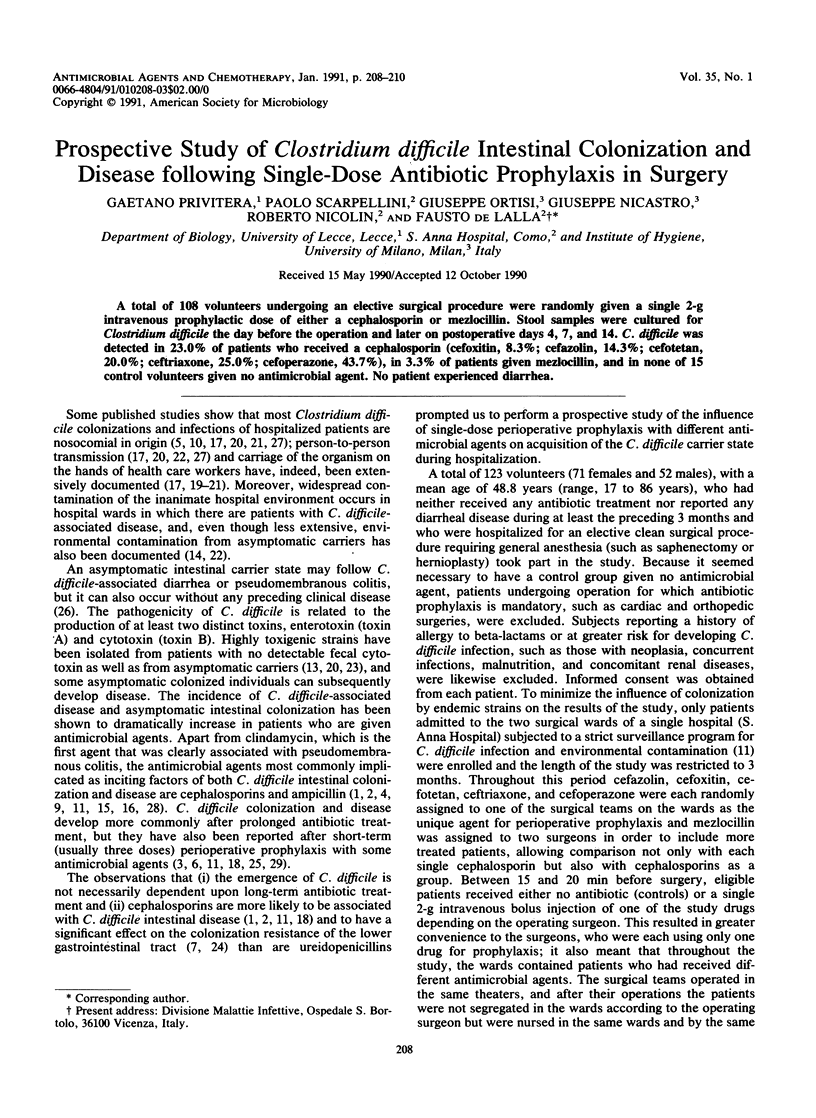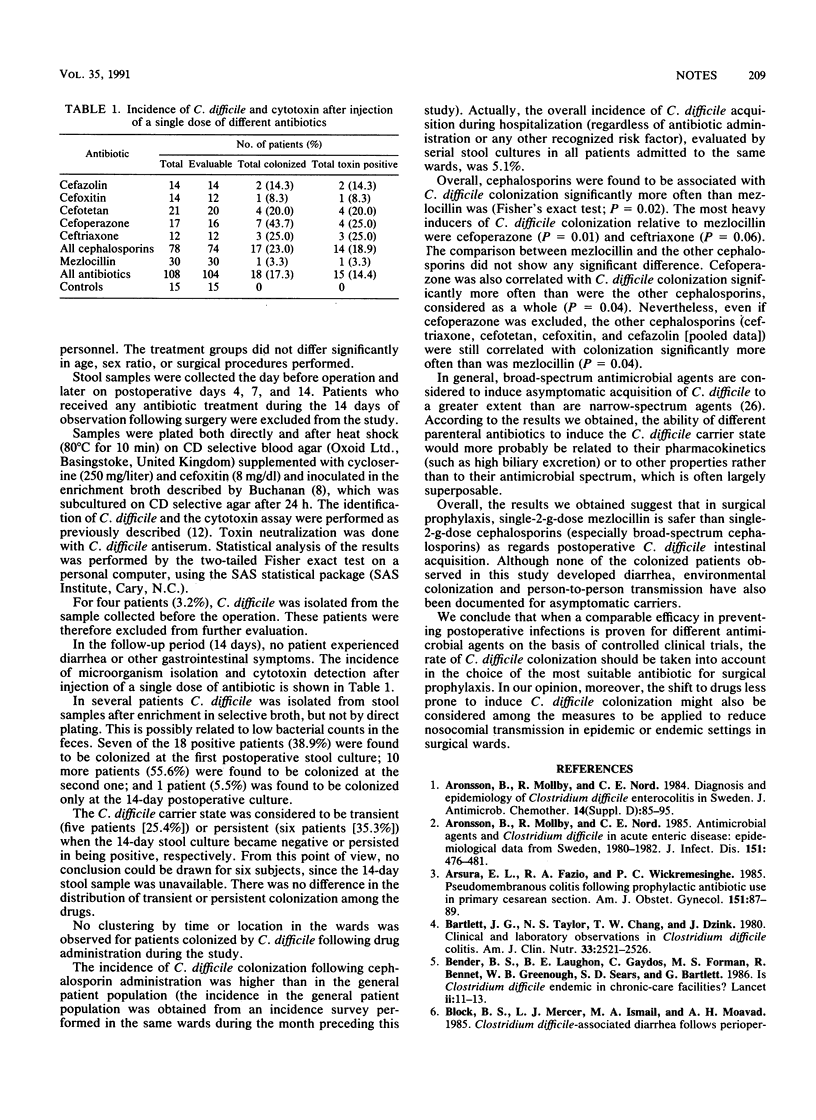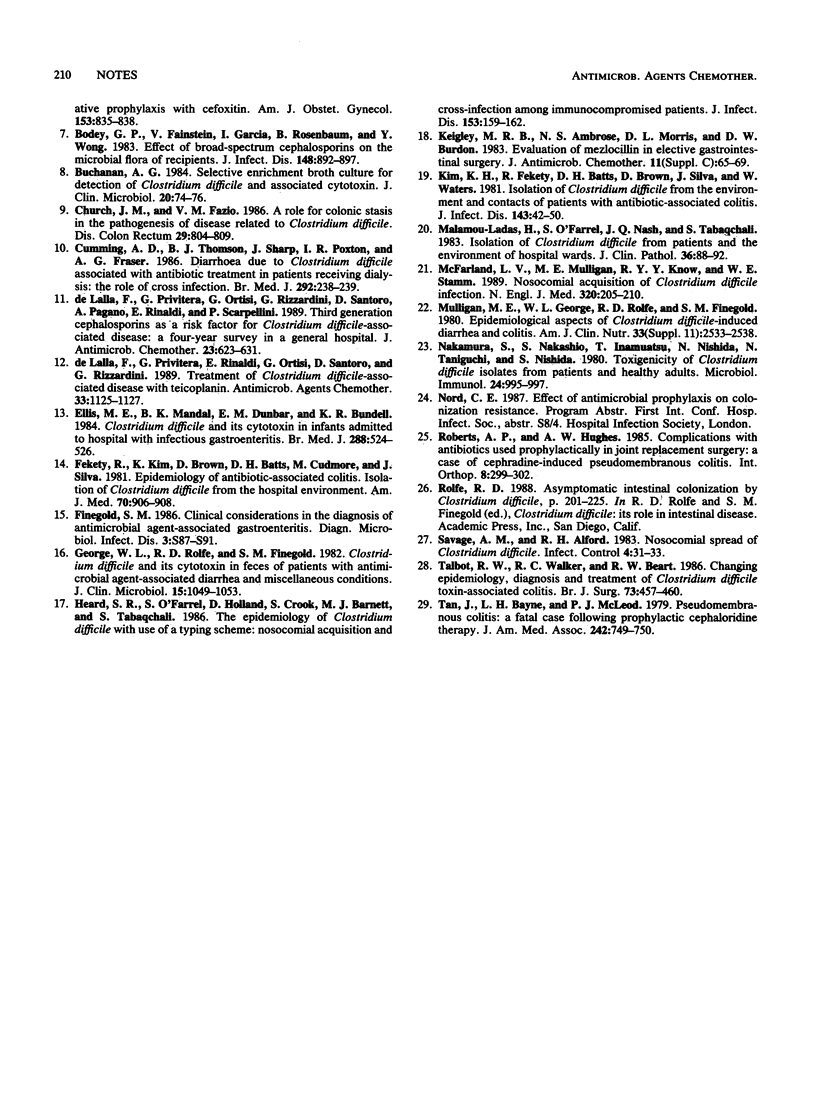Abstract
A total of 108 volunteers undergoing an elective surgical procedure were randomly given a single 2-g intravenous prophylactic dose of either a cephalosporin or mezlocillin. Stool samples were cultured for Clostridium difficile the day before the operation and later on postoperative days 4, 7, and 14. C. difficile was detected in 23.0% of patients who received a cephalosporin (cefoxitin, 8.3%; cefazolin, 14.3%; cefotetan, 20.0%; ceftriaxone, 25.0%; cefoperazone, 43.7%), in 3.3% of patients given mezlocillin, and in none of 15 control volunteers given no antimicrobial agent. No patient experienced diarrhea.
Full text
PDF


Selected References
These references are in PubMed. This may not be the complete list of references from this article.
- Aronsson B., Möllby R., Nord C. E. Antimicrobial agents and Clostridium difficile in acute enteric disease: epidemiological data from Sweden, 1980-1982. J Infect Dis. 1985 Mar;151(3):476–481. doi: 10.1093/infdis/151.3.476. [DOI] [PubMed] [Google Scholar]
- Aronsson B., Möllby R., Nord C. E. Diagnosis and epidemiology of Clostridium difficile enterocolitis in Sweden. J Antimicrob Chemother. 1984 Dec;14 (Suppl 500):85–95. doi: 10.1093/jac/14.suppl_d.85. [DOI] [PubMed] [Google Scholar]
- Arsura E. L., Fazio R. A., Wickremesinghe P. C. Pseudomembranous colitis following prophylactic antibiotic use in primary cesarean section. Am J Obstet Gynecol. 1985 Jan 1;151(1):87–89. doi: 10.1016/0002-9378(85)90430-2. [DOI] [PubMed] [Google Scholar]
- Bartlett J. G., Taylor N. S., Chang T., Dzink J. Clinical and laboratory observations in Clostridium difficile colitis. Am J Clin Nutr. 1980 Nov;33(11 Suppl):2521–2526. doi: 10.1093/ajcn/33.11.2521. [DOI] [PubMed] [Google Scholar]
- Bender B. S., Bennett R., Laughon B. E., Greenough W. B., 3rd, Gaydos C., Sears S. D., Forman M. S., Bartlett J. G. Is Clostridium difficile endemic in chronic-care facilities? Lancet. 1986 Jul 5;2(8497):11–13. doi: 10.1016/s0140-6736(86)92559-6. [DOI] [PubMed] [Google Scholar]
- Bodey G. P., Fainstein V., Garcia I., Rosenbaum B., Wong Y. Effect of broad-spectrum cephalosporins on the microbial flora of recipients. J Infect Dis. 1983 Nov;148(5):892–897. doi: 10.1093/infdis/148.5.892. [DOI] [PubMed] [Google Scholar]
- Buchanan A. G. Selective enrichment broth culture for detection of Clostridium difficile and associated cytotoxin. J Clin Microbiol. 1984 Jul;20(1):74–76. doi: 10.1128/jcm.20.1.74-76.1984. [DOI] [PMC free article] [PubMed] [Google Scholar]
- Church J. M., Fazio V. W. A role for colonic stasis in the pathogenesis of disease related to Clostridium difficile. Dis Colon Rectum. 1986 Dec;29(12):804–809. doi: 10.1007/BF02555349. [DOI] [PubMed] [Google Scholar]
- Cumming A. D., Thomson B. J., Sharp J., Poxton I. R., Fraser A. Diarrhoea due to Clostridium difficile associated with antibiotic treatment in patients receiving dialysis: the role of cross infection. Br Med J (Clin Res Ed) 1986 Jan 25;292(6515):238–239. doi: 10.1136/bmj.292.6515.238. [DOI] [PMC free article] [PubMed] [Google Scholar]
- Ellis M. E., Mandal B. K., Dunbar E. M., Bundell K. R. Clostridium difficile and its cytotoxin in infants admitted to hospital with infectious gastroenteritis. Br Med J (Clin Res Ed) 1984 Feb 18;288(6416):524–526. doi: 10.1136/bmj.288.6416.524. [DOI] [PMC free article] [PubMed] [Google Scholar]
- Fekety R., Kim K. H., Brown D., Batts D. H., Cudmore M., Silva J., Jr Epidemiology of antibiotic-associated colitis; isolation of Clostridium difficile from the hospital environment. Am J Med. 1981 Apr;70(4):906–908. doi: 10.1016/0002-9343(81)90553-2. [DOI] [PubMed] [Google Scholar]
- George W. L., Rolfe R. D., Finegold S. M. Clostridium difficile and its cytotoxin in feces of patients with antimicrobial agent-associated diarrhea and miscellaneous conditions. J Clin Microbiol. 1982 Jun;15(6):1049–1053. doi: 10.1128/jcm.15.6.1049-1053.1982. [DOI] [PMC free article] [PubMed] [Google Scholar]
- Keighley M. R., Ambrose N. S., Morris D. L., Burdon D. W. Evaluation of mezlocillin in elective gastrointestinal surgery. J Antimicrob Chemother. 1983 May;11 (Suppl 100):65–69. doi: 10.1093/jac/11.suppl_c.65. [DOI] [PubMed] [Google Scholar]
- Kim K. H., Fekety R., Batts D. H., Brown D., Cudmore M., Silva J., Jr, Waters D. Isolation of Clostridium difficile from the environment and contacts of patients with antibiotic-associated colitis. J Infect Dis. 1981 Jan;143(1):42–50. doi: 10.1093/infdis/143.1.42. [DOI] [PubMed] [Google Scholar]
- Malamou-Ladas H., O'Farrell S., Nash J. Q., Tabaqchali S. Isolation of Clostridium difficile from patients and the environment of hospital wards. J Clin Pathol. 1983 Jan;36(1):88–92. doi: 10.1136/jcp.36.1.88. [DOI] [PMC free article] [PubMed] [Google Scholar]
- McFarland L. V., Mulligan M. E., Kwok R. Y., Stamm W. E. Nosocomial acquisition of Clostridium difficile infection. N Engl J Med. 1989 Jan 26;320(4):204–210. doi: 10.1056/NEJM198901263200402. [DOI] [PubMed] [Google Scholar]
- Mulligan M. E., George W. L., Rolfe R. D., Finegold S. M. Epidemiological aspects of Clostridium difficile-induced diarrhea and colitis. Am J Clin Nutr. 1980 Nov;33(11 Suppl):2533–2538. doi: 10.1093/ajcn/33.11.2533. [DOI] [PubMed] [Google Scholar]
- Nakamura S., Nakashio S., Inamatsu T., Nishida N., Taniguchi N., Nishida S. Toxigenicity of Clostridium difficile isolates from patients and healthy adults. Microbiol Immunol. 1980;24(10):995–997. doi: 10.1111/j.1348-0421.1980.tb02904.x. [DOI] [PubMed] [Google Scholar]
- Roberts A. P., Hughes A. W. Complications with antibiotics used prophylactically in joint replacement surgery: a case report of cephradine-induced pseudomembranous colitis. Int Orthop. 1985;8(4):299–302. doi: 10.1007/BF00266876. [DOI] [PubMed] [Google Scholar]
- Savage A. M., Alford R. H. Nosocomial spread of Clostridium difficile. Infect Control. 1983 Jan-Feb;4(1):31–33. doi: 10.1017/s0195941700057623. [DOI] [PubMed] [Google Scholar]
- Talbot R. W., Walker R. C., Beart R. W., Jr Changing epidemiology, diagnosis, and treatment of Clostridium difficile toxin-associated colitis. Br J Surg. 1986 Jun;73(6):457–460. doi: 10.1002/bjs.1800730614. [DOI] [PubMed] [Google Scholar]
- Tan J., Bayne L. H., McLeod P. J. Pseudomembranous colitis. A fatal case following prophylactic cephaloridine therapy. JAMA. 1979 Aug 24;242(8):749–750. doi: 10.1001/jama.242.8.749. [DOI] [PubMed] [Google Scholar]
- de Lalla F., Privitera G., Ortisi G., Rizzardini G., Santoro D., Pagano A., Rinaldi E., Scarpellini P. Third generation cephalosporins as a risk factor for Clostridium difficile-associated disease: a four-year survey in a general hospital. J Antimicrob Chemother. 1989 Apr;23(4):623–631. doi: 10.1093/jac/23.4.623. [DOI] [PubMed] [Google Scholar]
- de Lalla F., Privitera G., Rinaldi E., Ortisi G., Santoro D., Rizzardini G. Treatment of Clostridium difficile-associated disease with teicoplanin. Antimicrob Agents Chemother. 1989 Jul;33(7):1125–1127. doi: 10.1128/aac.33.7.1125. [DOI] [PMC free article] [PubMed] [Google Scholar]


